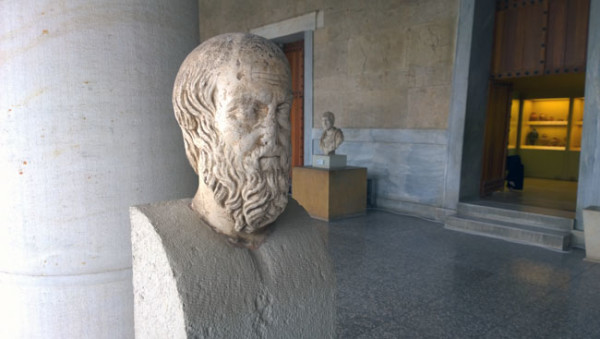Historians were less than disappointed with the portrayal of Artemisia in the Hollywood blockbuster 300: Rise of an Empire (2014). In order to understand their disappointment, it is necessary to establish Herodotus (c. 484-425 BC) and his work, The Histories, as the basis for most of what we know of Artemisia today. Among surviving ancient works, he was the first to mention her, providing the most detail.

Herodotus first introduced Artemisia in his narrative of Persian King Xerxes’s invasion of Greece during the Greco-Persian Wars (490-479 BC). Among the lengthy list of captains in Xerxes’s fleet, he proclaimed that her “role in the campaign against Greece was a truly astonishing one for a woman” (7.99). ((This translation comes from the Tom Holland translation (New York: Penguin, 2013).)) He went on to explain that after her husband’s death, Artemisia became ruler of Halicarnassus, a city in present-day southwest Turkey. Although she had an adult son presumably capable of leading, she answered Xerxes’s call to join his campaign. Herodotus believed her five ships, which she commanded, were among the best of the Persian fleet (7.99). Artemisia was unique among her peers as she was the only non-Persian, Greek, female commander in Xerxes’s council (8.101).
Several historians have theorized that it was only because Artemisia was queen of Halicarnassus—the hometown of Herodotus—that he decided to mention her at all. ((For example, see Ernest G. Sihler, “On Herodotus’s and Aeschylus’s Accounts of the Battle of Salamis,” Transactions of the American Philological Association 8 (1877): 199 and W. W. Tarn, “The Fleet of Xerxes,” The Journal of Hellenic Studies 28 (1908): 231-232.)) J. F. Lazenby describes Herodotus’s interest in her as an obvious, “almost malicious delight.” ((J. F. Lazenby, The Defence of Greece, 490-479 BC (Oxford: Aris & Phillips, 1993), 2.)) However, Rosaria Vignolo Munson points out that to assume that such motives “fully explain the prominence [Herodotus] gives to Artemisia is equivalent to denying in advance that she plays an integral role in the context.” ((Rosaria Vignolo Munson, “Artemisia in Herodotus,” Classical Antiquity 7 (1988): 92.))
After the initial introduction, it becomes clear that Artemisia was more than just an anecdote or hometown infatuation for Herodotus. She was integral to his narrative as first a foreshadower of events at Salamis, then a participant in the actual battle, and finally, a direct influencer in the execution of Persian strategy. A brief survey of Artemisia as found in The Histories demonstrates how she was crucial to the narrative and events.
Artemisia in Xerxes’s Council
As the Greeks awaited a Persian attack off the coast of Salamis, Xerxes sought advice from all of his commanders on how to proceed. Every commander except Artemisia recommended fighting the Greeks. After her experience at the Battle of Artemisium during the same campaign, she alone believed the Greeks were superior at sea and there was nothing for Xerxes to gain by risking his fleet in another battle. The Persian fleet consisted of multiple nationalities including Egyptians, Cypriots, Cilicians, and Pamphylians, which she believed were “worse than useless!” She also pointed out that Xerxes had already captured Athens, his originally stated goal for the invasion. Instead of fighting at Salamis, the Persians could hold their newly acquired territory in Greece and wait as the remaining allied city-states turned on each other. Artemisia believed Xerxes needed time, not another battle, to complete his conquest. Upon hearing this, her allies cringed and her enemies were delighted, as everyone believed the king would react harshly. Instead, “he was hugely impressed by Artemisia’s take on things, and lavished her with more praise than ever—though she had already stood high in his estimation before” (8.68-69).
Artemisia at Salamis
Xerxes still decided to confront the Greeks at Salamis and in the heat of this battle is where Artemisia appeared again in Herodotus’s narrative. When it became apparent that her ship was in the range of a charging Athenian ship, Artemisia ordered her own ship to ram and sink an ally, killing everyone. Artemisia escaped the battle and Xerxes witnessed the crushing blow she delivered. However, he could not see that the victim was one of his own. Instead, he believed Artemisia had sunk an enemy ship, making the statement, “My men have become women, and my women men” (8.87-88).
Artemisia after Salamis
Arguably, Artemisia’s most important role in Herodotus’s narrative comes after the Persian defeat at Salamis. Xerxes again asked for her advice on how to proceed with the campaign. She recommended that he return to Persia with the remainder of his navy and a bulk of his army, leaving behind only the eager general Mardonius with a handpicked force. Let Mardonius take responsibility for subduing Greece. If he was successful, then Xerxes could take credit. If he failed, then Xerxes could blame Mardonius. Xerxes agreed with the advice and returned to Persia, entrusting his bastard children to Artemisia for their safekeeping (8.102-103).
If the account is accurate, then Artemisia had a hand in transforming the direction of the largest invasion Greece had seen.

The Complex Character of Herodotus’s Artemisia
Although providing only snapshots of Artemisia throughout a single campaign, Herodotus presented a complex character that was unique not only because of her circumstances, but also because of how she reacted. She assumed ruling upon her husband’s death. When the call for Xerxes’s Greece campaign arrived, she volunteered. She then fought at Artemisium. When it came time for a council of war, she spoke her mind, going against all of her peers. She unabashedly predicted the defeat to come at Salamis, calling out the weak links in the Persian fleet. When the battle came, she sacrificed an allied ship to ensure her escape, killing everyone. One historian theorizes that the victims of the allied ship “could not have died to the last man unless someone made an effort to kill them,” a terrifying though. ((Barry Strauss, The Battle of Salamis: The Naval Encounter that Saved Greece — and Western Civilization (New York: Simon & Schuster, 2005), 186.)) Luck ensured that Xerxes saw and misinterpreted her actions. Finally, she provided council that altered the course of the campaign, sending Xerxes home.
To top it off, in a profession dominated by men and in a military force dominated by Persian leadership, Artemisia stood out by her mere gender and race.
All of this makes it impossible to classify Artemisia. She was certainly brave, but not to her own detriment. She risked her neck to speak her mind, but she was not willing to fight to the death at Salamis. Contrast that with stories of fighting a lost battle that are recounted as inspirational, such as Thermopylae (480 BC). Salamis was not such a battle and Artemisia seemed to know when to flee at all costs, receiving no criticism from Herodotus.
Thus, Artemisia was fearless in speaking her mind and brave in battle, but still a survivor in the latter. She had her enemies, which Herodotus mentioned when she spoke before Salamis. The disputes remain a mystery, but she certainly was not popular among all her peers, possibly for openly criticizing them while gaining Xerxes’s favor. All of this equates to a complex character that is difficult to summarize.
Through fictionalization, future writers would attempt to make Artemisia one-dimensional, which we will cover in future articles.
